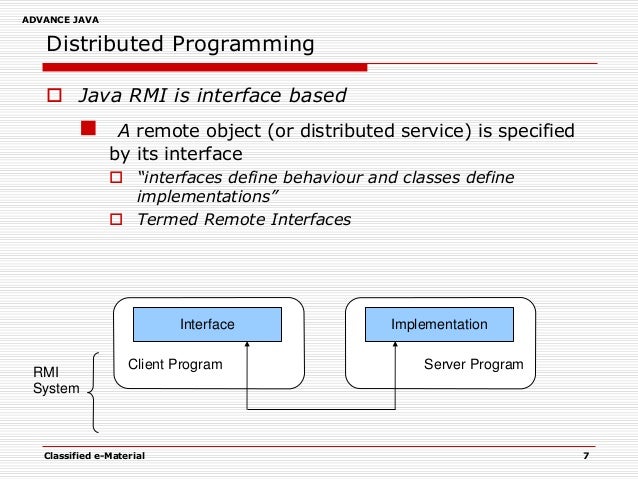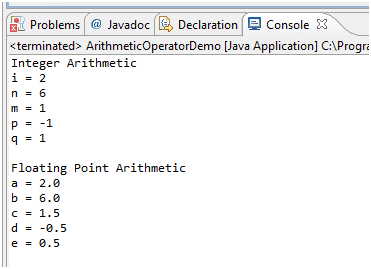
- #Rmi program for arithmetic operation in java install
- #Rmi program for arithmetic operation in java update
- #Rmi program for arithmetic operation in java code
Step 7: This file requires four command line arguments which are IP address, two arguments from the computation and the arithmetic operator name.

Step 6: The last java file needed is atmClient.java which implements the client side of this distributed application.
#Rmi program for arithmetic operation in java update
Step 5: The next file to be created is atmServer.java which will update the RMI registry on that machine.This is done by rebind( ) method of naming class.

Step 4: This java file extends unicast remote object which provides functionality that is needed to make object available from remote machines. Step 3: Then second java file to be created is atmServerImpl.java which implements the remote interface. Step 2: This java file contains four methods that accepts one string arguments and returns the calculated value. Procedure: Step 1: Create atmServerIntf.java which defines the remote interface that is provided by the server. The two original numbers are called the multiplier and the. Multiplication also combines two numbers into a single number, the product. ATM USING RMI Aim: To develop a java program for ATM service using RMI. Multiplication is the second basic operation of arithmetic. Thus the program for calculating simple interest and compound interest using RMI has been executed and verified. Java AllClient localhost 5 4 add java AllClient 172.16.11.162 5 4 add PROGRAM CODING: AllserverIntf.java: import java.rmi.* public interface AllServerIntf extends Remote
#Rmi program for arithmetic operation in java code
The client code can be invoked by the command line by using one of the two formats shown below: The server code is started from the command line: java AllServer Step Six: Step Four: Start the RMI Registry on the Server Machine The JDK provides a program called rmiregistry,which executes on the server machine.It maps names to object references.Start the RMI Registry from the command line as show below: start rmiregistry Step five: Copy AllServerIntf.class,AllServerImpl.class,AllServerImpl_Skel.class, AllServerImpl_Stub and AllServer.class to a directory on the server machine.
#Rmi program for arithmetic operation in java install
Javac AllServerIntf.java javac AllServerImpl.java javac AllServer.java javac AllClient.java Step Two: Generate Stubs and Skeletons To generate Stubs and Skeletons,we use a tool called the RMI compiler,which is invoked from the command line, rmic AllServerImpl Step Three: Install Files on the Client and Server Machines Copy AllClient.class,AllServerImpl_Stub.class and AllServerIntf.class to a directory on the client machine. The compilation of the source code can be done by command line,as shown here: Step 8: Compile and execute the program according to the settings given below. You can any of the code in the example programs. Step 6: The last file is AllClient.java which implements the client side of this distributed application. Part I: Implementing an arithmetic server using sockets You can use Java or C/C++ for this assignment. This is done by rebind () method of naming class. Step 5: The next file created is AllServer.java which will update the rmi registry on that machine. Step 3: The second file to be created is AllServerImpl.java which implements the remote interface. Step 2: This file contains four methods that accept two double arguments and returns the calculated value. Procedure: Step 1: Create AllServerIntf.java which defines the remote interface that is provided by the server. If you run this program, it will print similar output as the above program.ARITHMETIC OPERATIONS USING RMI Aim: To develop a program for performing arithmetic operations like addition, subtraction, multiplication and division of RMI. This value is incremented by d on each recursive call, i.e. current is the current value that we want to print.It calls itself again and again until the value of n is equal to 0.


 0 kommentar(er)
0 kommentar(er)
